- Trips
- Tour Calendar
- About Our Tours
- Plan a Trip
- Book a Trip
- About Us
- Contact Us


A highlight of any hike in the Swiss Alps is wildlife viewing. After years of retreat, populations of wild animals are making a comeback in the Alps as a result of protective measures, and no one is better able to show you the wonders of Alpine wildlife than your Alpenwild guide.
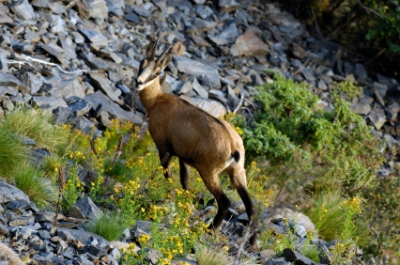
While hiking in the Alps, and particularly on the Haute Route, be on the lookout for Chamois. The chamois is a goat-like animal found at moderately high elevations throughout the Alps. They are agile climbers and if they sense a threat they can ascend 1000 meters in about 15 minutes. Chamois are easily recognized by their white facial markings and the brown stripe the runs along their backbone. Chamois are well-adapted to living in steep, rocky terrain. A fully grown chamois reaches a height of about 2½ feet at the shoulders and weighs about 110 pounds. Both males and females have short horns (10-12 inches) which are slightly curled in the posterior direction. In addition to their alpine habitat, chamois are occasionally spotted in the forests around Zermatt on our Best of the Swiss Alps tour and in the rocky crags of the Alpstein mountains in Appenzell.
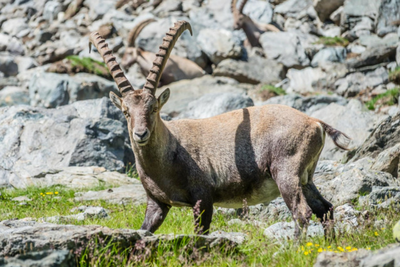
The Alpine ibex is a mountain goat instantly recognizable by the male's large scimitar-shaped horns which are ridged in the front. Females grow a pair of smaller, thinner horns which develop considerably more slowly than those of the male. The ibex ranges in height from 27 to 43 inches at the shoulder and weighs between 200 to 270 pounds. Ibex are related to domestic goats and will mate with other goats if they are unable to find a mate in the wild. Ibex were hunted to extinction in the early 19th century. By 1856 only 60 Alpine ibex remained on a royal hunting reserve in the Grand Paradiso region of Italy. Some of these ibex were smuggled into Switzerland around 1900 in an effort to reinstate ibex in the Swiss Alps. Under protection, there are now over 40,000 ibex in the Swiss Alps. Ibex are frequently sighted in the most rocky and wild regions of the Swiss Alps along the Haute Route, especially on the Sentier de Chamois in the Upper Val de Bagnes Nature Reserve, where they were reintroduced in 1926, and around the Col de Louvie and the Col de Prafleuri.
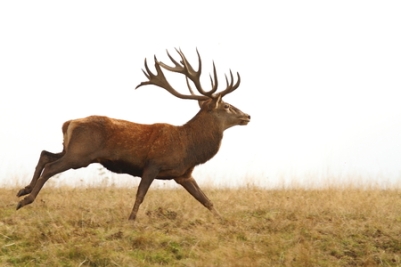
The Red Deer is the predominant deer speies in Europe and inhabits the Alps. It is one of the largest deer species, and is larger and generally more majestic than mule deer or whitetail deer found in the US. Generally, the male (stag) Red Deer is typically 41-48 inches high at the shoulders and weighs 350-530 pounds. The female typically weighs in at 264-374 lbs). They are almost always found in a deep forest setting, well below the treeline. Red deer were extinct in Switzerland by the mid-17th century; however a small population survived in Liechtenstein which migrated to Grison (Graubunden) canton in 1900. Continued protection and migration (plus a lack of natural predators) has resulted in healthy populations of red deer throughout Switzerland today. Red deer are ocassionally sighted on all Alpenwild hiking tours, including Best of the Swiss Alps.
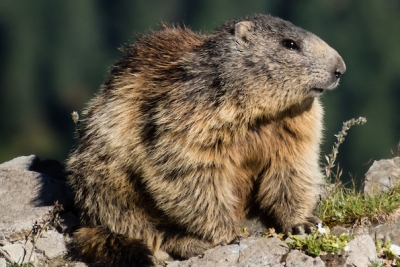
The Alpine Marmot is common in the Swiss Alps between 2,500 and 10,000 feet in elevation. They are excellent diggers, able to burrow through soil that even a pickaxe would have difficulty with. The marmot is the largest member of the squirrel family. The body mass is lightest in the spring, weighing about 6-7 pounds. By the fall they weigh between 12-18 pounds as they prepare for hibernation. Marmots live in an underground burrow or "hotel". The burrow only hosts one family, but are often enlarged by the next generation. They can create very complex burrows over time. Each alpine marmot will live in a group that consists of several burrows, and which has a dominant breeding pair. One can often see an alpine marmot "standing" while they keep a look-out for potential predators or other dangers. Warnings are given, by emitting a series of loud whistles, after which members of the colony may be seen running for cover. Alpine marmots eat plants such as grasses and herbs, as well as grain, insects, spiders and worms. Marmots spend up to nine months per year in hibernation. The mating season for alpine marmots occurs in the spring, right after their hibernation period comes to a close, which gives their offspring the highest possible chance of surviving the coming winter. Alpine marmots are able to breed once they reach an age of two years and have gestation period of 33-34 days. Each litter consists of between one to seven babies, though this number is usually three. The babies are born blind and will grow dark fur within several days. The weaning period takes a further forty days, during which time the mother will leave the young in the burrow while she searches for food. If kept in captivity, alpine marmots can live up to 15-18 years.
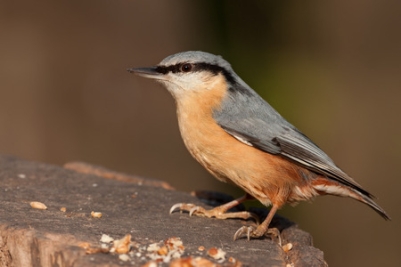
The Nuthatch s a small bird found in many forested regions of the Swiss Alps. They have large heads, short tails, and powerful beaks and feet. They are omnivorous, eating mostly insects, nuts and seeds. Nuthatches store food, especially seeds, in tree crevices, in the ground, under small stones, or behind bark flakes, and these caches are remembered for as long as 30 days. Over the course of a season a nuthatch will store food in around 20,000 different places and find over 80% of its caches. Nuthatches have been found to avoid using their caches during benign conditions in order to save for harsher times.
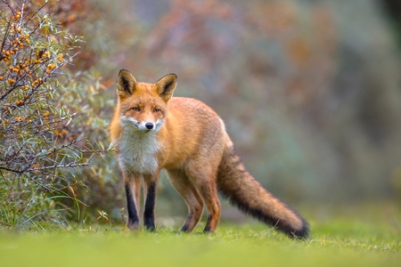
The fox is an omnivorous mammal belonging to the Canidae family. The most common and widespread species of fox in Switzerland is the European red fox. Foxes are typically found in forests throughout the Swiss Alps. They do not live or hunt in packs, but rather in small family groups. They are opportunistic feeders and hunt live prey-especially rodents. Since foxes are no longer hunted in Switzerland, populations of urban foxes have been on the rise in recent years. There are currently about 1,200 foxes in Zurich.
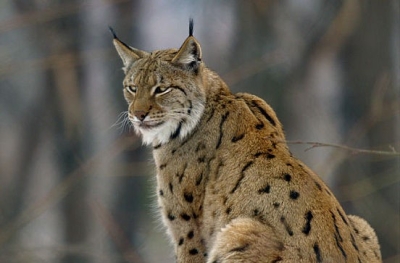
The Eurasian Lynx, the largest of the four lynx species throughout the world, was hunted to extinction in Switzerland in the early 1900s. But in 1971, the Swiss government imported two male and two female lynx from the Carpathian Alps in eastern Europe – and placed them in the forest of canton Obwalden in central Switzerland. These mid-sized spotted cats liked their new home and began breeding. Today there are about 170 lynx living throughout Switzerland, enough for Switzerland to send animals to other countries for wildlife resettlement projects.
Lynx live a solitary life, except in the March/April mating season. They’re territorial by nature. A female lynx has a range of 20-60 square miles and for males, a range of 40-100 square miles. The standard litter, born in late May or early June, has two kittens who stay with their mother for ten months. Roe deer and chamois account for 88% of the lynx diet. An individual adult requires about a deer or chamois per week or about 50-60 animals per year.
There is a delicate and uneasy balance between alpine farmers and lynx who occasionally help themselves to sheep. Although the lynx is a protected species in Switzerland, individual lynx are killed by hunters if they have become a repeated predatory threat to sheep.
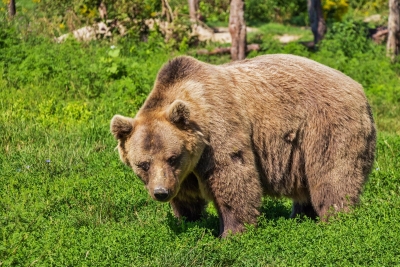
You won't find brown bears in the Jungfrau or in Valais where we do most of our hiking. After a brown bear was shot by a hunter in 1904, they were extinct from the Swiss Alps through most of the 20th century. But in recent years bears from the Slovenian Alps have extended their range into Austria, and in 2008 there was a sighting in eastern Switzerland. Given adequate protection, it's likely that bears will continue to extend their range and possibly even move into other areas of the Swiss Alps where they have long been extinct. Brown bears pose no real threat to hikers. In July 2006 Switzerland brought a "bear plan" into force to promote coexistence between humans and bears. It provides for bears to be killed if they are classified as posing a risk to humans, notably by frequenting human settlements and ignoring attempts to deter them.
Since March 2008 there has only been a few wild bears in Switzerland. The bear, known as M13, was believed to have killed several sheep on various occasions. M13 was first seen in the Engadine in April 2012. On several occasions he was seen near houses. He was fitted with a transmitter, which showed him wandering between Switzerland, Italy and Austria. In April 2012, M13 was hit by a train in Graubünden. Towards the end of 2012 M13 appeared in the Val Poschiavo, where he killed a donkey, destroyed beehives, and broke into a holiday home. His behavior led the environment office to classify him as a "problem bear". After waking up in February 2013 he continued to show total lack of fear of humans. He was classified as posing a safety risk and shot on February 19, 2016.
More recently, a bear, known as M29, who was born in Italy, migrated into Switzerland in 2016. The bear wandered north and in April 2018 was spotted in Engelberg. This was the first bear sighting in canton Bern in 190 years.
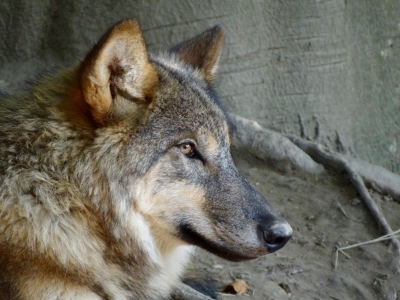
Wolves were driven to extinction throughout most of western Europe by the start of the 20th century, largely by hunting and the expansion of human settlements and upland farming into areas in which they had ranged free The last wolf in Switzerland was killed in 1821. But over the past few decades, partly as a result of the Bern Convention, some have returned to the Alps—stretching from France across northern Italy and Switzerland to Austria—with the help of conservationists. Single animals returned to Switzerland from Italy in 1995. During the summer of 2015 there were two packs of wolves spotted in Switzerland, one in canton Ticino and another in the mountains between the cantons of Graubünden and St. Gallen. These recent sightings bring the total number of wolves in Switzerland to less than 40. Although wolves are a protected species in Switzerland, their presence causes controversy. Farmers complain the animals should be hunted as soon as possible as the predators kill their livestock, mainly targeting sheep. The Swiss Wolf Group, an organization that campaigns for wolf protection, urges farmers to protect herds of sheep and goats with sheepdogs to scare off the wolves. Authorization within a specific canton to shoot wolves is given only if 25 sheep are killed by the animal within a month. A timeframe of 60 days is given for the wolf to be killed. If the wolf has not been tracked down during this period, the authorization expires. The penalty for illegally killing a wolf is up to one year in prison and a fine.
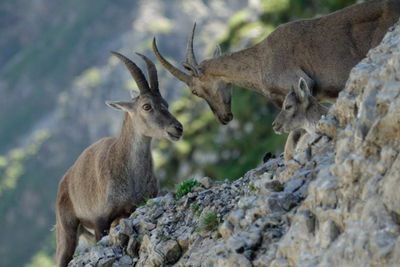
Would you like to see spectacular wildlife of the Alps in its natural habitat?
Join us on an adventure in the Swiss Alps! Our Haute Route trips and Exploring the Jungfrau tours take you to remote areas of the Alps where you have your best chances of coming face to face with these extraordinary creatures.
On each trip you'll be accommpanied by an expert guide familiar with the wildlife and their habitat.